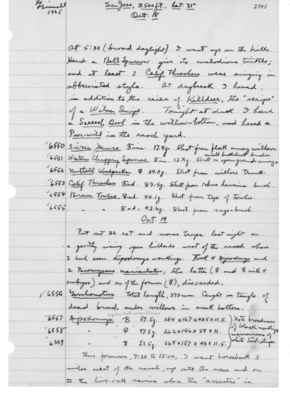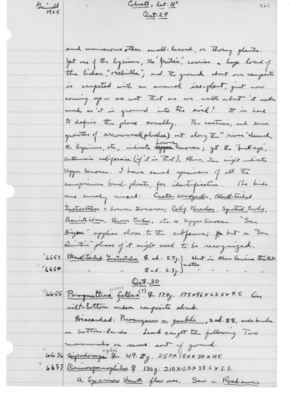Pages That Mention Calif. Thrasher
1925: Joseph Grinnell's field notes
S3 Page 52
Collector: Grinnell - 1925 Location: San Jose, 2500 ft., lat. 31 degrees Date: October 18, 1925 Page Number: 2595
at 5:30 (broad daylight) I went up on the hills. Heard a Bell Sparrow give its melodious tinkle; and at least 3 Calif. Thrashers were singing in abbreviated style. At daybreak I heard, in addition to the cries of Killdeer, the “scaipe” of a Wilson Snipe. Tonight at dusk I heard a Screech Owl in the willow-bottom, and heard a Poor-will in the ranch yard.
6550 Sierra Junco (male sign) im. 12.4g. Shot from flock among willows. 6551 Western Chipping Sparrow (male sign) im. 12.4.g. Shot in open ground among small buckwheat bushes. 6552 Nuttall Woodpecker (female sign) 34.0g. Shot from willow trunk. 6553 Calif. Thrasher (male sign) ad. 83.5.g. Shot from rhus laurina bush. 6554 Brown Towhee (female sign) ad. 40.1g. Shot from top of towhee. 6555 “ “ (male sign) ad. 43.6g. Shot from sage-bush.
Oct 19 Put out 22 rat and mouse traps last night on a gently rising open hillside west of the ranch where I had seen dipodomys workings. Took 4 Dipodomys and 2 Periomyscus maniculatus; the latter ((male sign) and (female sign) with 4 embryos) and one of the former ((male sign)), discarded.
6556 Gerrhonotus Total length, 370 mm. Caught in tangle of dead brush under willows in creek bottom. 6557 Dipodomys (male sign) 59.5g. 284 x 167 x 40.5 x 11.5. } Note broadness 6558 “ “ (female sign) 47.5g. 262 x 156 x 39 x 11. } of black markings, narrowness of 6559 “ “ (male sign) 51.5g. 265 x 157 x 40 x 11.5. } white tail-stripe. This forenoon, 7:30 to 12:00, I went horseback 3 miles west of the ranch, up onto the mesa and on to the live-oak ravine where the “arrastre” is.
S3 Page 66
Collector: Grinnell - 1925 Location: to Colnett, Sat. 31 degrees Date: Oct. 28 Page Number: 2608
6641 Savannah Sparrow (female sign) im. 16.7g. Shot in salicornia. 6642 “ “ (female sign) im. 16.8.g. Shot on stem of clump of juncus.
Was out early 5:15 to 6:30, and again 9:20 to 11:30, the last time to the beach, the bluff, and the salt flats. Saw following birds: Turkey Vulture (4+); Poorwill (heard calling last evening); Valley Quail (2 large coveys near camp); Cactus Woodpecker (one heard); Say Phoebe (2); Anna Hummer (2, around blossoming Lycium); Brown Towhee (4+); Spotted Towhee (2); Rufous-crowned Sparrow (2); Intermediate Sparrow (12±); Calif. Thrasher (2, singing); Linnet (6±); Wren-tit (4+); Black-Tailed Gnatcatcher (2); Bewick Wren (2); Red-winged Blackbird (a pair visited camp, and others in small companies in flight out in the valley); Raven (within hearing most of the time); Meadowlark (4 or more, out in salt flat); Marsh Wren (common, a dozen or more, in dense mats of Salicornia (unknown 1) sloughs just back of the cobble-stone beach-barrier (which is fully 8 feet higher than the flats inland from it)); Savannah Sparrow (scattered troupes on open ground among small bushes back from the salicornia); Belding and Large-billed Sparrows (on salicornia marshes, not many, the latter also on beach at high-tide line of drift); Pipit (flock of 10± on bare alkali flat); Killdeer (one heard - the only wader, where we saw so many on the beach when we were here in September); Song Sparrow (2, in big juncus clumps up the valley from the salicornia. Of mammals, I saw one Jack Rabbit on salt flat and 2 or more Brush Rabbits.
S3 Page 69
Collector: Grinnell - 1925 Location: Colnett, lat. 31 degrees Date: October 29, 1925 Page Number: 2611
and numerous other small-leaved, or thorny plants. Yet one of the lyciums, the “frutéa,” carries a huge load of the lichen, “orchilla”; and the ground about hour campsite is carpeted with an annual ice-plant, just now coming up - so wet that as we walk about it makes mud as it is ground into the soil! It is hard to define the place zonally. The cactus, and dense growths of arrowweed (pluchea) out along the “river” channel, the lyciums, etc., indicate Lower Sonoran; yet the “buck-eye”, artemisia californica (if it is that), Rhus, etc., might indicate Upper Sonoran. I have saved specimens of all the conspicuous bush plants, for identification. The birds are surely mixed: Cactus Woodpecker, Black-Tailed Gnatcatcher = Lower Sonoran; Calif. Thrasher, Spotted Towhee, Bewick Wren, Brown Towhee, etc. = Upper Sonoran. “San Diegan” applies close to the sub fauna; but a “San Quentin” phase of it might need to be recognized.
6653 Black-Tailed Gnatcatcher (female sign) ad. 5.7g. 6654 “ “ (male sign) ad. 6.3g. Shot in Rhus laurina thickets. mates.
Oct. 30 6655 Perognathus fallax (?) (female sign) 17.4g. 175 x 96 x 23.5 x 4.5 On silt-bottom under composite shrub. Discarded: Peromyscus m. gambeli, 2 ad. (male sign) (male sign), under bushes on bottomlands. Lamb caught the following two mammals on same sort of ground. 6656 Dipodomys agilis (female sign) 49.2g. 257 x 150 x 38 x 115. 6657 Ammospermophilus (female sign) 130g. 210 x 53 x 38.5 x 5.5. A Sparrow Hawk flew over. Saw a Roadrunner


